Moist Static Energy and Secondary Circulation Evolution Characteristics during the Rapid Intensification of Super Typhoon Yutu (2007)
Abstract
1. Introduction
2. Data, Model Configuration, and Methods
2.1. Data and Model Configuration
2.2. Moist Static Energy Analysis
2.3. Analysis of the Secondary Circulation Using the Sawyer–Eliassen (SE) Equation
3. Results
3.1. Simulated TC Track and Intensity Changes
3.2. MSE Structure and Evolution Characteristics
3.3. Secondary Circulation Structure and Evolution Characteristics
4. Summary and Discussion
Author Contributions
Funding
Institutional Review Board Statement
Informed Consent Statement
Data Availability Statement
Acknowledgments
Conflicts of Interest
References
- Zhang, Q.; Zhang, W.; Chen, Y.D.; Jiang, T. Flood, drought and typhoon disasters during the last half-century in the Guangdong province, China. Nat. Hazards 2011, 57, 267–278. [Google Scholar] [CrossRef]
- Peduzzi, P.; Chatenoux, B.; Dao, H.; De Bono, A.; Herold, C.; Kossin, J.; Mouton, F.; Nordbeck, O. Global trends in tropical cyclone risk. Nat. Clim. Chang. 2012, 2, 289–294. [Google Scholar] [CrossRef]
- England, M.H.; McGregor, S.; Spence, P.; Meehl, G.A.; Timmermamm, A.; Cai, W.; Gupta, A.S.; McPhaden, M.J.; Purich, A.; Santoso, A. Recent intensification of wind-driven circulation in the Pacific and the ongoing warming hiatus. Nat. Clim. Chang. 2014, 4, 222–227. [Google Scholar] [CrossRef]
- DeMaria, M. A simplified dynamical system for tropical cyclone intensity prediction. Mon. Weather Rev. 2009, 137, 68–82. [Google Scholar] [CrossRef]
- Rappaport, E.N.; Frankon, J.L.; Avila, L.A.; Baig, S.R.; Beven, J.L.; Blake, E.S.; Burr, C.A.; Jiing, J.G.; Juckins, C.A.; Knabb, R.D.; et al. Advances and challenges at the National Hurricane Center. Weather Forecast. 2009, 24, 395–419. [Google Scholar] [CrossRef]
- Knaff, J.A.; Sampson, C.R.; Musgrave, K.D. An operational rapid intensification prediction aid for the western North Pacific. Weather Forecast. 2018, 33, 799–811. [Google Scholar] [CrossRef]
- Wang, B.; Zhou, X. Climate variation and prediction of rapid intensification in tropical cyclones in the western North Pacific. Meteorol. Atmos. Phys. 2008, 99, 1–16. [Google Scholar] [CrossRef]
- Bosart, L.F.; Bracken, W.E.; Molonari, J.; Velden, C.S.; Black, P.G. Environmental influences on the rapid intensification of Hurricane Opal (1995) over the Gulf of Mexico. Mon. Weather Rev. 2000, 128, 322–352. [Google Scholar] [CrossRef]
- Kaplan, J.; DeMaria, M. Large-scale characteristics of rapidly intensifying tropical cyclones in the north Atlantic basin. Weather Forecast. 2003, 18, 1093–1108. [Google Scholar] [CrossRef]
- Molinari, J.; Vollaro, D. Rapid intensification of a sheared tropical storm. Mon. Weather Rev. 2010, 138, 3869–3885. [Google Scholar] [CrossRef]
- Ryglicki, D.R.; Cossuth, J.H.; Hodyss, D.; Doyle, J.D. The unexpected rapid intensification of tropical cyclones in moderate vertical wind shear. Part I: Overview and observations. Mon. Weather Rev. 2018, 146, 3773–3800. [Google Scholar] [CrossRef]
- DeMaria, M.; Kaplan, J.; Baik, J.J. Upper-Level eddy angular momentum fluxes and tropical cyclone intensity change. J. Atmos. Sci. 1993, 50, 1133–1147. [Google Scholar] [CrossRef]
- Fischer, M.S.; Tang, B.H.; Corbosiero, K.L. Assessing the influence of upper-tropospheric troughs on tropical cyclone intensification rates after genesis. Mon. Weather Rev. 2017, 145, 1295–1313. [Google Scholar] [CrossRef][Green Version]
- Kossin, J.P.; Eastin, M.D. Two distinct regimes in the kinematic and thermodynamic structure of the hurricane eye and eyewall. J. Atmos. Sci. 2001, 58, 1079–1090. [Google Scholar] [CrossRef]
- Miyamoto, Y.; Takemi, T. A triggering mechanism for rapid intensification of tropical cyclones. J. Atmos. Sci. 2015, 72, 2666–2681. [Google Scholar] [CrossRef]
- Chen, X.; Xue, M.; Fang, J. Rapid intensification of Typhoon Mujigae (2015) under different sea surface temperatures: Structural changes leading to rapid intensification. J. Atmos. Sci. 2018, 75, 4313–4335. [Google Scholar] [CrossRef]
- Corbosiero, K.L.; Molinari, J.; Black, M.L. The structure and evolution of Hurricane Elena (1985). Part I: Symmetric intensification. Mon. Weather Rev. 2005, 133, 2905–2921. [Google Scholar] [CrossRef]
- Corbosiero, K.L.; Molinari, J.; Aiyyer, A.R. The structure and evolution of Hurricane Elena (1985). Part II: Convective asymmetries and evidence for vortex Rossby waves. Mon. Weather Rev. 2006, 134, 3073–3091. [Google Scholar] [CrossRef]
- Reasor, P.D.; Montgomery, M.T.; Marks, F.D.; Gamache, J.F. Low-wavenumber structure and evolution of the hurricane inner core observed by airborne dual-Doppler radar. Mon. Weather Rev. 2000, 128, 1653–1680. [Google Scholar] [CrossRef]
- Reasor, P.D.; Eastin, M.D.; Gamache, J.F. Rapidly intensifying Hurricane Guillermo (1997). Part I: Low-wavenumber structure and evolution. Mon. Weather Rev. 2009, 137, 603–631. [Google Scholar] [CrossRef]
- Nguyen, M.C.; Reeder, M.J.; Davidson, N.E.; Smith, R.K.; Montgomery, M.T. Inner-core vacillation cycles during the intensification of Hurricane Katrina. Q. J. R. Meteorol. Soc. 2011, 137, 829–844. [Google Scholar] [CrossRef]
- Reif, M.; Reeder, M.J.; Hankinson, M.C.N. Vacillation cycles in WRF simulations of Hurricane Katrina. Aust. Meteor. Oceanogr. J. 2014, 64, 123–131. [Google Scholar] [CrossRef]
- Zhang, S.; Qian, Y.; Huang, Y.; Guo, J. Numerical simulation study on the rapid intensification of typhoon Haikui (1211) off the shore of China. J. Trop. Meteorol. 2017, 23, 269–280. [Google Scholar] [CrossRef]
- Hong, S.Y.; Dudhia, J.; Chen, S.H. A revised approach to ice microphysical processes for the bulk parameterization of clouds and precipitation. Mon. Weather Rev. 2004, 132, 103–120. [Google Scholar] [CrossRef]
- Kain, J.S.; Fritsch, J.M. Convective parameterization for mesoscale models: The Kain-Fritsch scheme. In The Representation of Cumulus Convection in Numerical Models; Emamuel, K.A., Raymond, D.J., Eds.; American Meteorological Society: Boston, MA, USA, 1993; pp. 165–170. [Google Scholar] [CrossRef]
- Dudhia, J. Numerical study of convection observed during the Winter Monsoon Experiment using a mesoscale two-dimensional model. J. Atmos. Sci. 1989, 46, 3077–3107. [Google Scholar] [CrossRef]
- Mlawer, E.J.; Taubman, S.J.; Brown, P.D.; Lacono, M.J.; Clough, S.A. Radiative transfer for inhomogeneous atmospheres: RRTM, a validated correlated-k model for the longwave. J. Geophys. Res. 1997, 102, 16663–16682. [Google Scholar] [CrossRef]
- Neelin, J.D.; Held, I.M. Modeling tropical convergence based on the moist static energy budget. Mon. Weather Rev. 1987, 115, 3–12. [Google Scholar] [CrossRef]
- Li, T.; Hsu, P.C. Fundamentals of Tropical Climate Dynamics; Springer: Cham, Switzerland, 2017. [Google Scholar] [CrossRef]
- Wang, L.; Li, T.; Maloney, E.; Wang, B. Fundamental Causes of Propagating and Non-propagating MJOs in MJOTF/GASS models. J. Clim. 2017, 30, 3743–3769. [Google Scholar] [CrossRef]
- Wu, B.; Zhou, T.J.; Li, T. Atmospheric dynamic and thermodynamic processes driving the western North Pacific anomalous anticyclone during El Niño. Part I: Maintenance mechanisms. J. Clim. 2017, 30, 9621–9635. [Google Scholar] [CrossRef]
- Hendricks, E.A.; Montgomery, M.T.; Davis, C.A. The role of ‘‘vortical’’ hot towers in the formation of Tropical Cyclone Diana (1984). J. Atmos. Sci. 2004, 61, 1209–1232. [Google Scholar] [CrossRef]
- Montgomery, M.T.; Nicholls, M.E.; Cram, T.A.; Saunders, A.B. A vortical hot tower route to tropical cyclogenesis. J. Atmos. Sci. 2006, 63, 355–386. [Google Scholar] [CrossRef]
- Fudeyasu, H.; Wang, Y. Balanced contribution to the intensification of a tropical cyclone simulated in TCM4: Outer-core spinup process. J. Atmos. Sci. 2011, 68, 430–449. [Google Scholar] [CrossRef]
- Emanuel, K.A. An air-sea interaction theory for tropical cyclones. Part I: Steady-state maintenance. J. Atmos. Sci. 1986, 43, 585–605. [Google Scholar] [CrossRef]
- Rotunno, R.; Emanue, K.A. An air-sea interaction theory for tropical cyclones, Part II: Evolutionary study using a nonhydrostatic axisymmetric numerical model. J. Atmos. Sci. 1987, 44, 542–561. [Google Scholar] [CrossRef]
- Pendergrass, A.G.; Willoughby, H.E. Diabatically induced secondary flows in tropical cyclones. Part I: Quasi-steady forcing. Mon. Weather Rev. 2009, 137, 805–821. [Google Scholar] [CrossRef]
- Deng, L.-Y.; Li, T. Impact of Background Dynamic and Thermodynamic States on Distinctive Annual Cycle of Near Equatorial Tropical Cyclogenesis over the Western North Pacific. J. Meteorol. Res. 2020, 34, 822–835. [Google Scholar] [CrossRef]
- Shou, H.-R.; Li, T.; Sun, Y.; Wang, L.; Liu, J. Decreasing Trend of Western North Pacific Tropical Cyclone Inner-Core Size over the Past Decades. J. Meteorol. Res. 2021, 35, 635–645. [Google Scholar] [CrossRef]
- Ma, C.; Li, T. An Empirical Model of Tropical Cyclone Intensity Forecast in the Western North Pacific. J. Meteorol. Res. 2022; 36, in press. [Google Scholar]

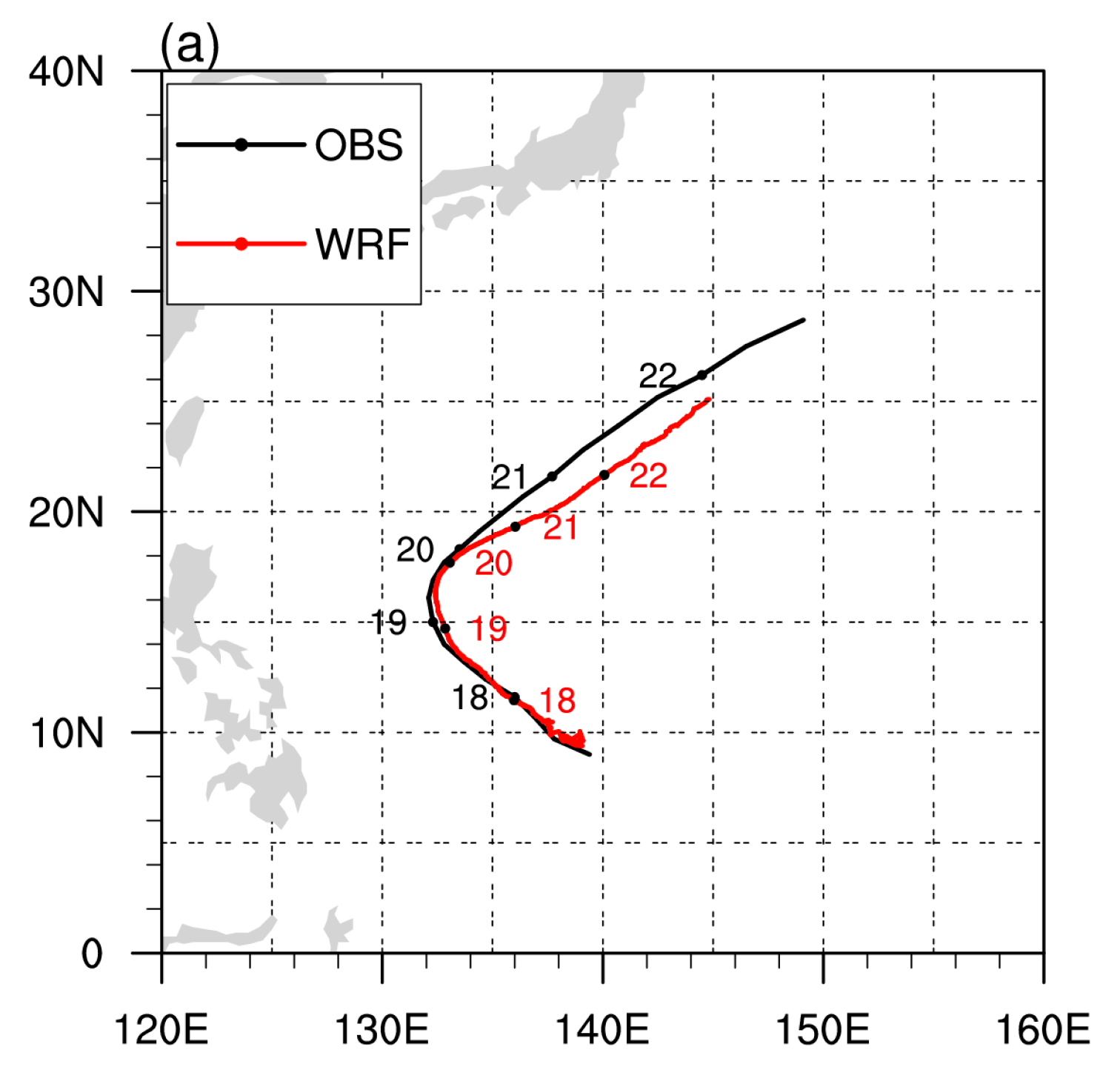

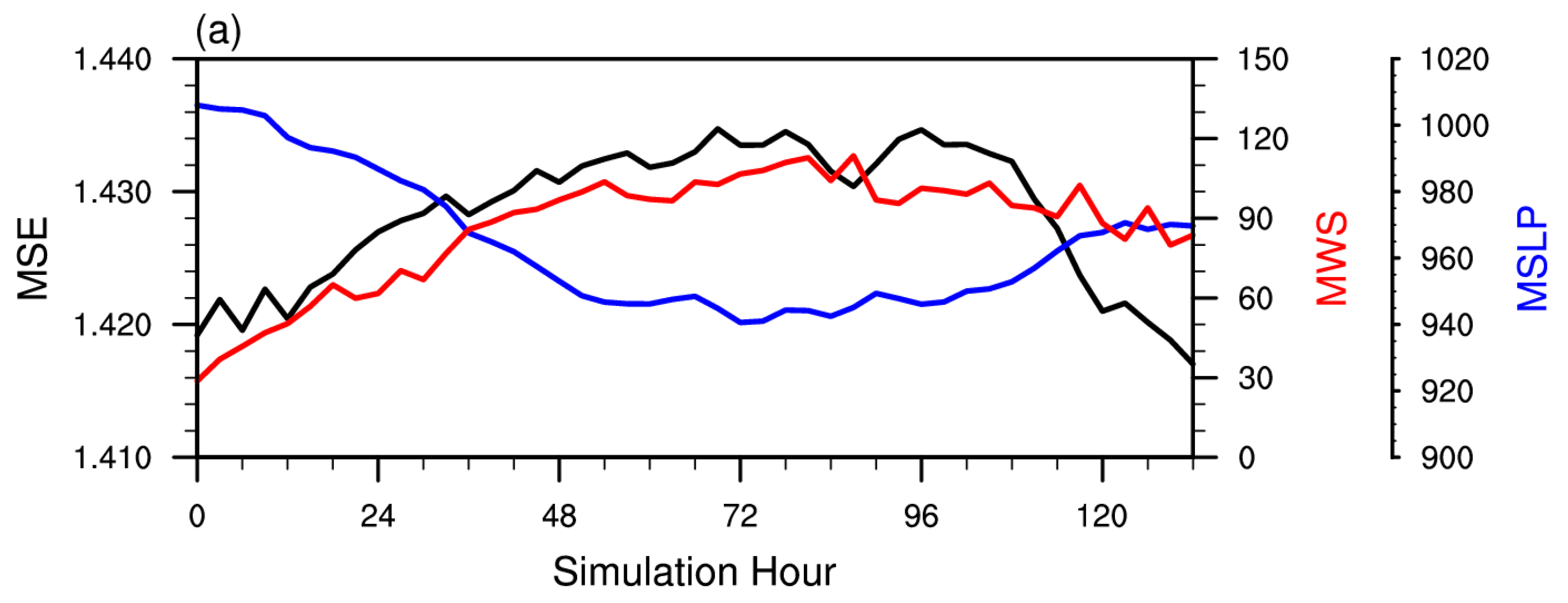

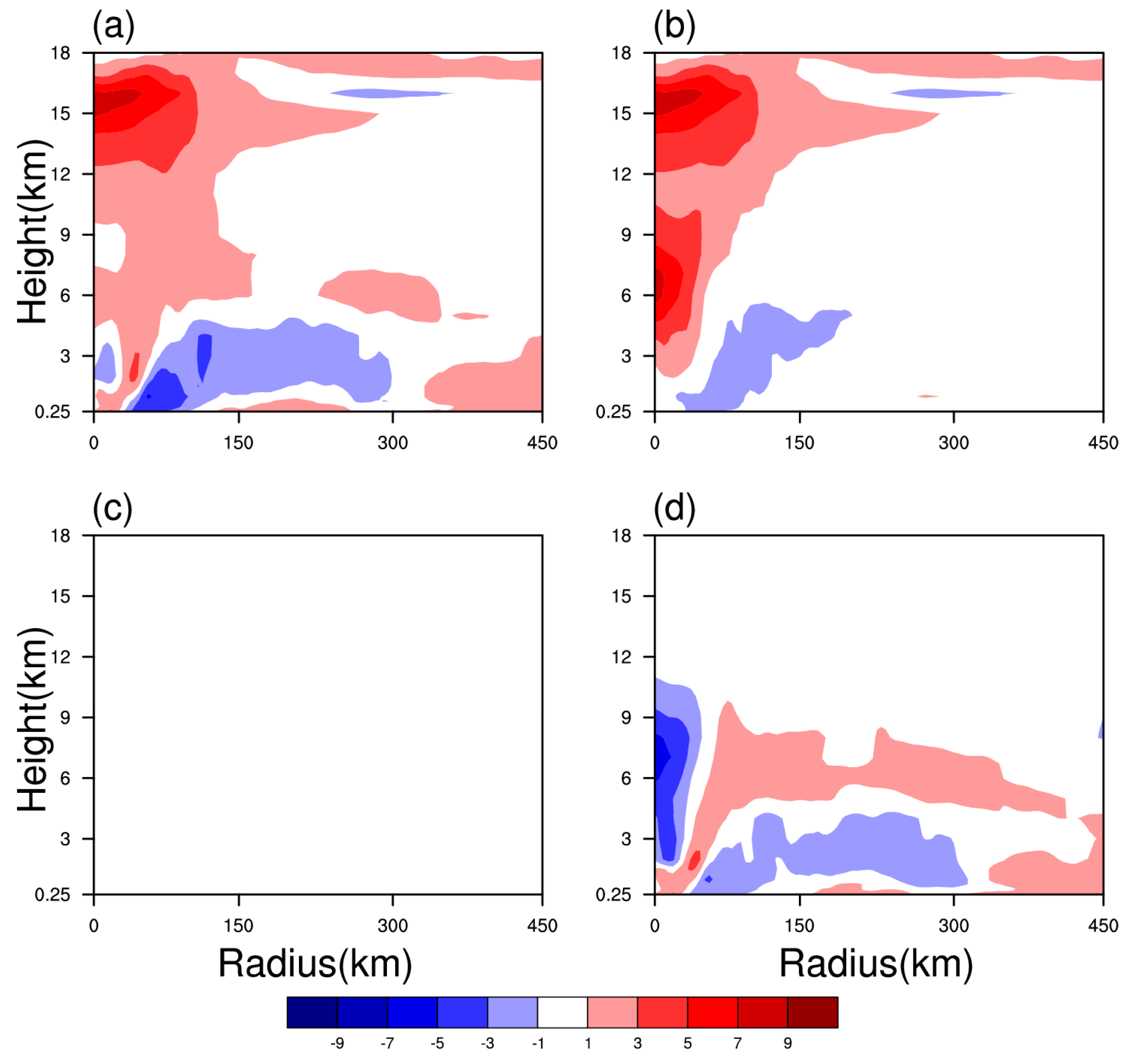
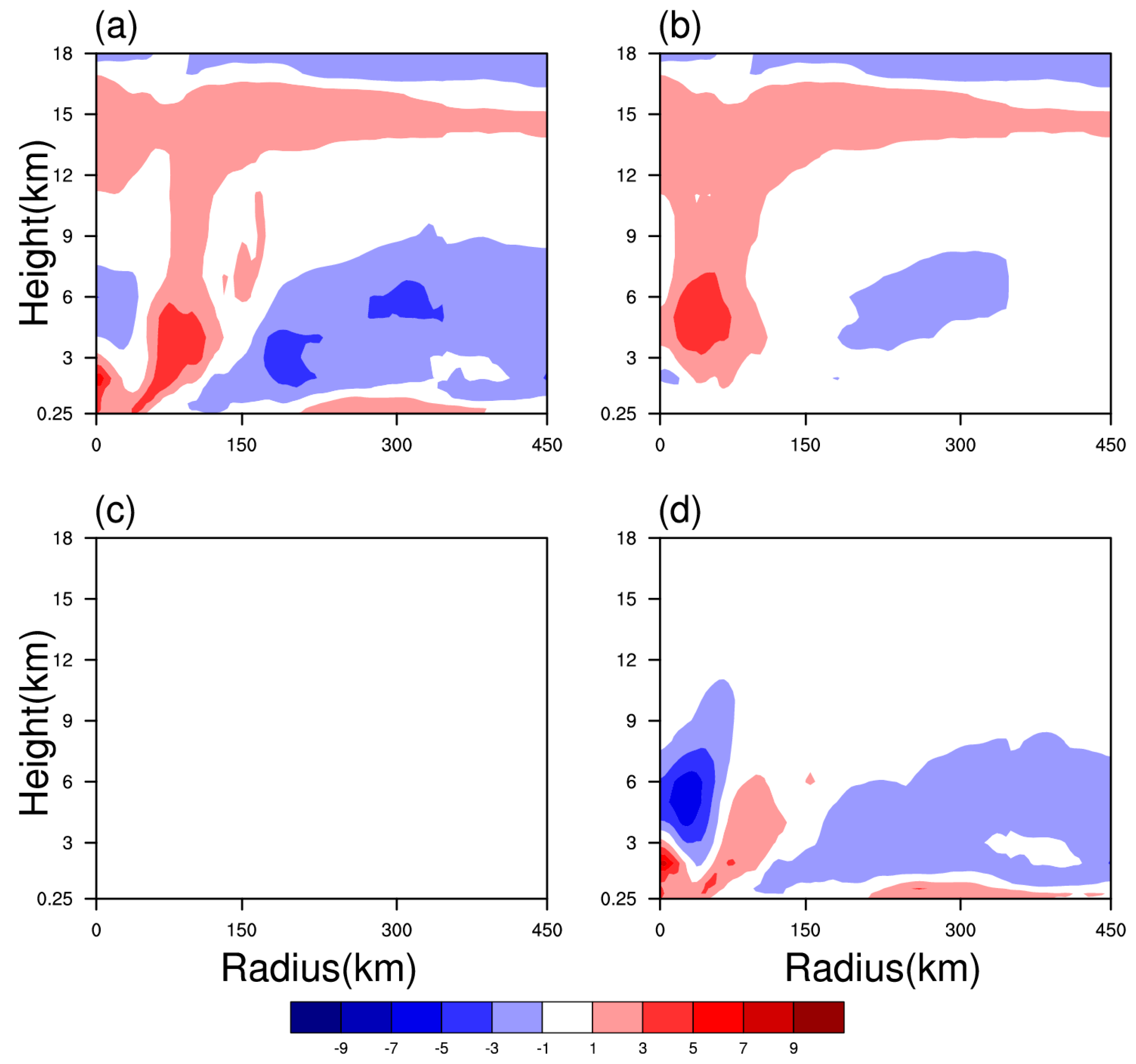

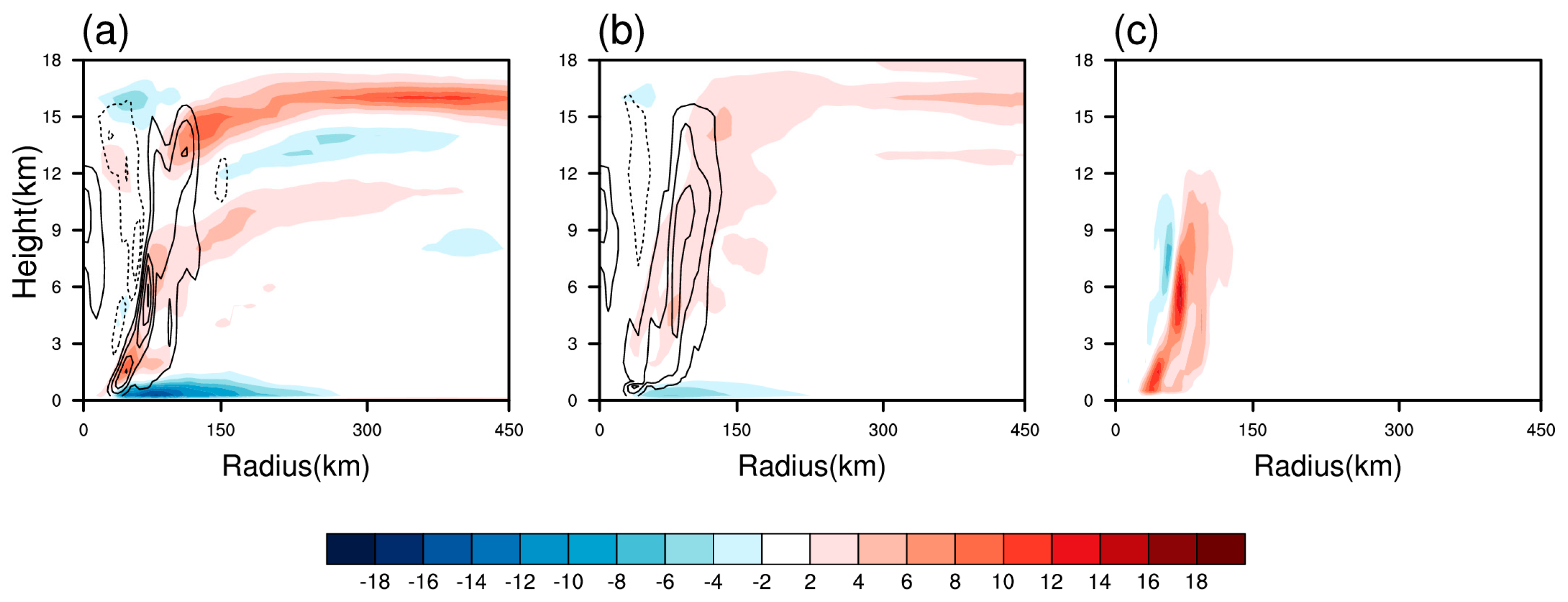

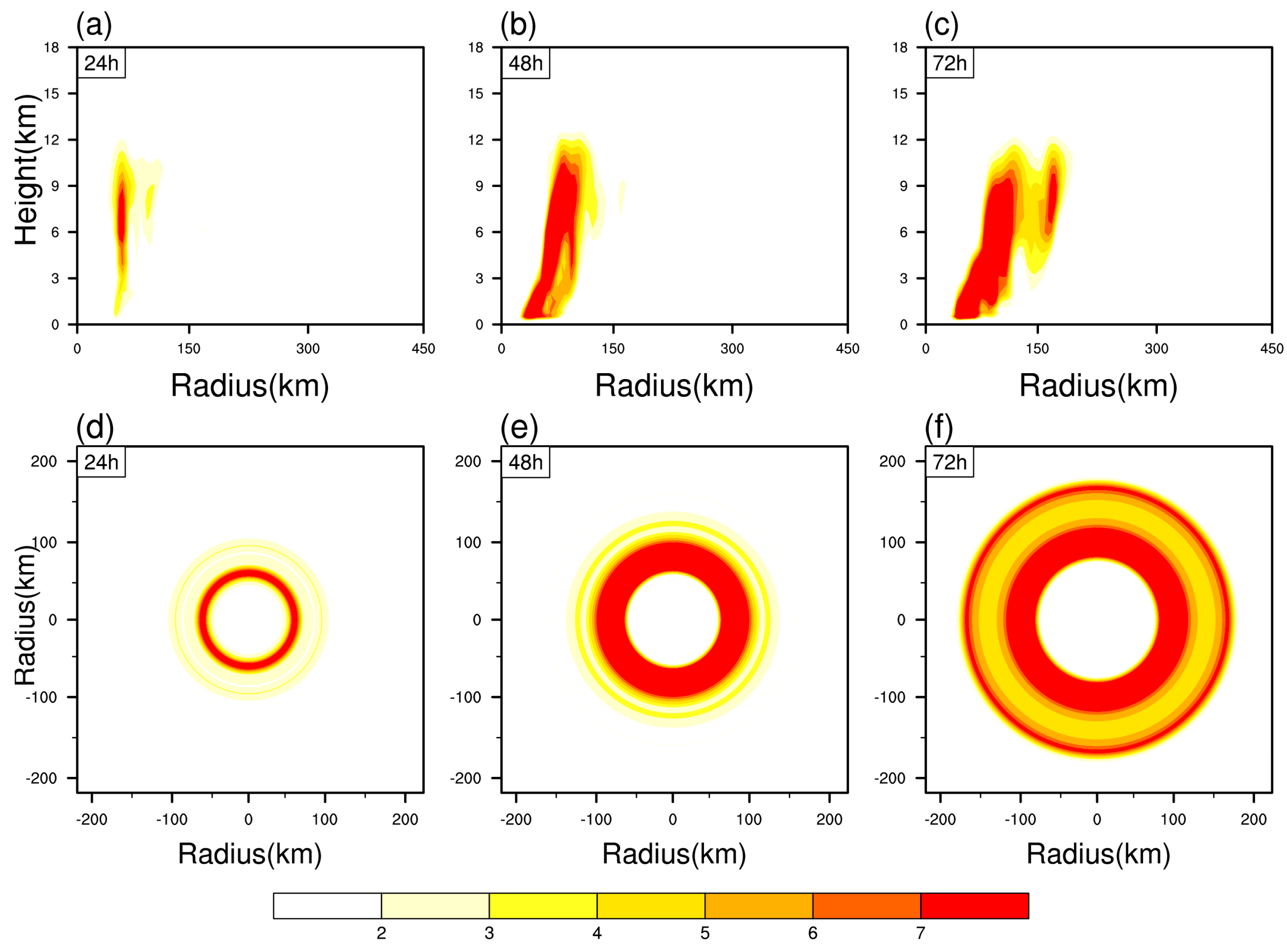
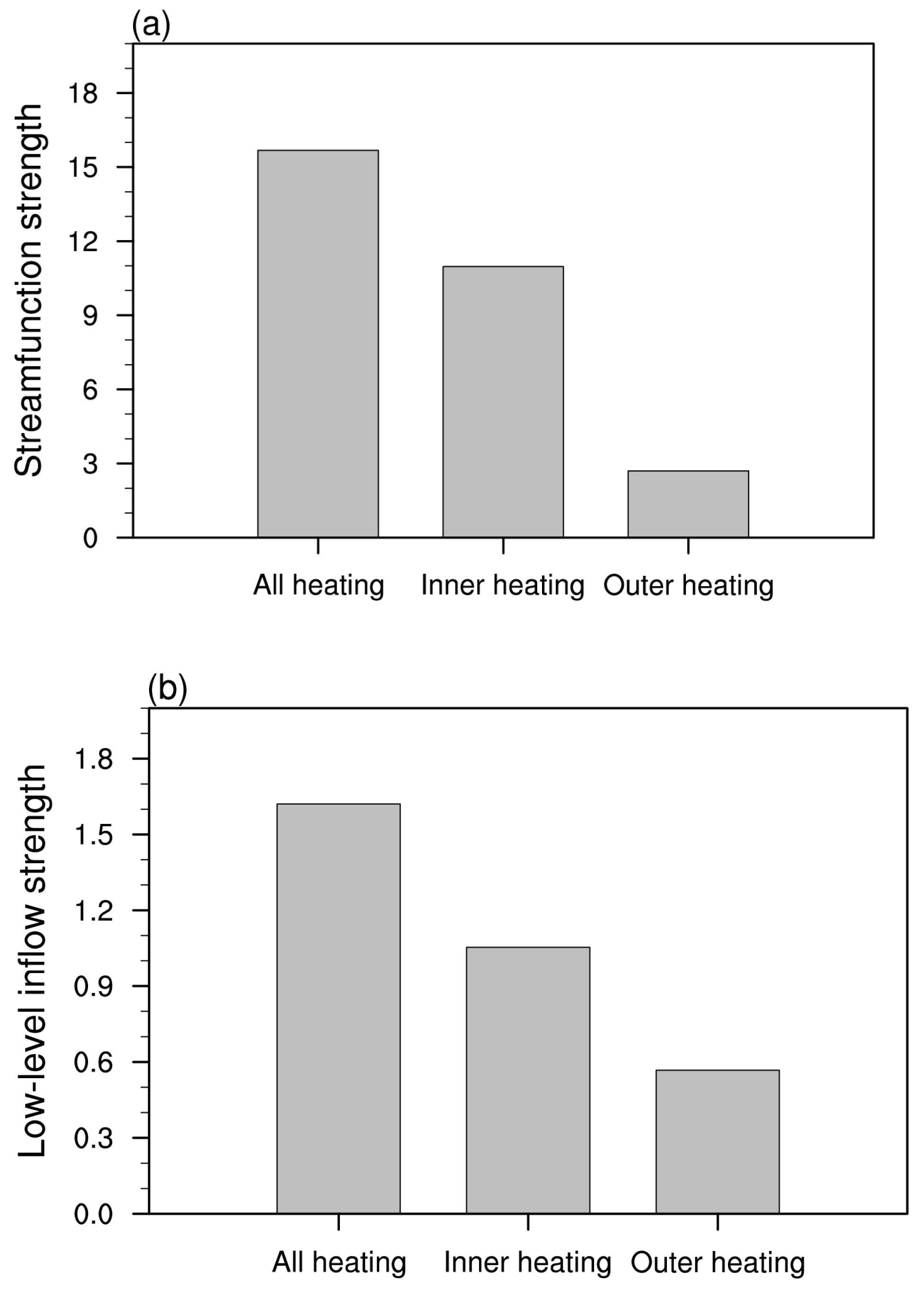
| 4.33 | −1.05 | 0.32 | 4.22 | 0.85 |
| 3.22 | −1.57 | 0.33 | 3.58 | 0.89 |
Publisher’s Note: MDPI stays neutral with regard to jurisdictional claims in published maps and institutional affiliations. |
© 2022 by the authors. Licensee MDPI, Basel, Switzerland. This article is an open access article distributed under the terms and conditions of the Creative Commons Attribution (CC BY) license (https://creativecommons.org/licenses/by/4.0/).
Share and Cite
Liao, X.; Li, T.; Ma, C. Moist Static Energy and Secondary Circulation Evolution Characteristics during the Rapid Intensification of Super Typhoon Yutu (2007). Atmosphere 2022, 13, 1105. https://doi.org/10.3390/atmos13071105
Liao X, Li T, Ma C. Moist Static Energy and Secondary Circulation Evolution Characteristics during the Rapid Intensification of Super Typhoon Yutu (2007). Atmosphere. 2022; 13(7):1105. https://doi.org/10.3390/atmos13071105
Chicago/Turabian StyleLiao, Xueyu, Tim Li, and Chen Ma. 2022. "Moist Static Energy and Secondary Circulation Evolution Characteristics during the Rapid Intensification of Super Typhoon Yutu (2007)" Atmosphere 13, no. 7: 1105. https://doi.org/10.3390/atmos13071105
APA StyleLiao, X., Li, T., & Ma, C. (2022). Moist Static Energy and Secondary Circulation Evolution Characteristics during the Rapid Intensification of Super Typhoon Yutu (2007). Atmosphere, 13(7), 1105. https://doi.org/10.3390/atmos13071105






